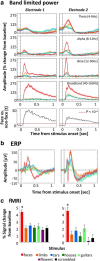Electrical stimulation of human fusiform face-selective regions distorts face perception
- PMID: 23100414
- PMCID: PMC3517886
- DOI: 10.1523/JNEUROSCI.2609-12.2012
Electrical stimulation of human fusiform face-selective regions distorts face perception
Erratum in
- J Neurosci. 2013 Jan 16;33(3):1291. Withoft, Nathan [corrected to Witthoft, Nathan]
Abstract
Face-selective neural responses in the human fusiform gyrus have been widely examined. However, their causal role in human face perception is largely unknown. Here, we used a multimodal approach of electrocorticography (ECoG), high-resolution functional magnetic resonance imaging (fMRI), and electrical brain stimulation (EBS) to directly investigate the causal role of face-selective neural responses of the fusiform gyrus (FG) in face perception in a patient implanted with subdural electrodes in the right inferior temporal lobe. High-resolution fMRI identified two distinct FG face-selective regions [mFus-faces and pFus-faces (mid and posterior fusiform, respectively)]. ECoG revealed a striking anatomical and functional correspondence with fMRI data where a pair of face-selective electrodes, positioned 1 cm apart, overlapped mFus-faces and pFus-faces, respectively. Moreover, electrical charge delivered to this pair of electrodes induced a profound face-specific perceptual distortion during viewing of real faces. Specifically, the subject reported a "metamorphosed" appearance of faces of people in the room. Several controls illustrate the specificity of the effect to the perception of faces. EBS of mFus-faces and pFus-faces neither produced a significant deficit in naming pictures of famous faces on the computer, nor did it affect the appearance of nonface objects. Further, the appearance of faces remained unaffected during both sham stimulation and stimulation of a pair of nearby electrodes that were not face-selective. Overall, our findings reveal a striking convergence of fMRI, ECoG, and EBS, which together offer a rare causal link between functional subsets of the human FG network and face perception.
Figures


Comment in
-
Perception: Facing reality.Nat Rev Neurosci. 2012 Dec;13(12):812. doi: 10.1038/nrn3395. Nat Rev Neurosci. 2012. PMID: 23316497 No abstract available.
References
-
- Allison T, Ginter H, McCarthy G, Nobre AC, Puce A, Luby M, Spencer DD. Face recognition in human extrastriate cortex. J Neurophysiol. 1994;71:821–825. - PubMed
-
- Allison T, Puce A, Spencer DD, McCarthy G. Electrophysiological studies of human face perception. I: Potentials generated in occipitotemporal cortex by face and non-face stimuli. Cereb Cortex. 1999;9:415–430. - PubMed
-
- Barton JJ. Structure and function in acquired prosopagnosia: lessons from a series of 10 patients with brain damage. J Neuropsychol. 2008;2:197–225. - PubMed
-
- Damasio AR, Damasio H, Van Hoesen GW. Prosopagnosia: anatomic basis and behavioral mechanisms. Neurology. 1982;32:331–341. - PubMed
Publication types
MeSH terms
Substances
Grants and funding
LinkOut - more resources
Full Text Sources
Other Literature Sources
